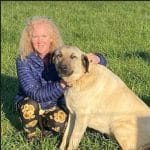For Americans, dogs are part of the family. The pet industry in the United States is worth over one hundred billion dollars, and many of us own multiple pets. Dealing with pet hair in the house can be challenging for any pet person. Keeping hair and dander at bay is a must for anyone suffering from allergies but able, with a little extra effort and planning, to have a dog in the house.
At one other end of the scale are hairless dogs. They still produce saliva and dander (the primary source of allergies), but there’s very little hair to shed. Most hairless breeds appear to have originated in Mexico or Central or South America. Each of these breeds contains two varieties, one with hair and one without, based on which genes are dominant and recessive. Hairless dogs need protection from the sun and brush and brambles that could hurt their skin. They won’t manage as outdoor only dogs.
If you’re outdoorsy and prefer a dog who can spend long hours in the sun or rough terrain with you, you may consider a more typically coated breed regarded as light shedding. Although it seems counterintuitive, dogs that don’t shed tend to have longer hair. Low-shedding dogs won’t necessarily be low maintenance. Most dogs who shed very little require more coat maintenance than a seasonal shedder. They may also need frequent trips to the groomer.
Hairless Breeds
American Hairless Terrier
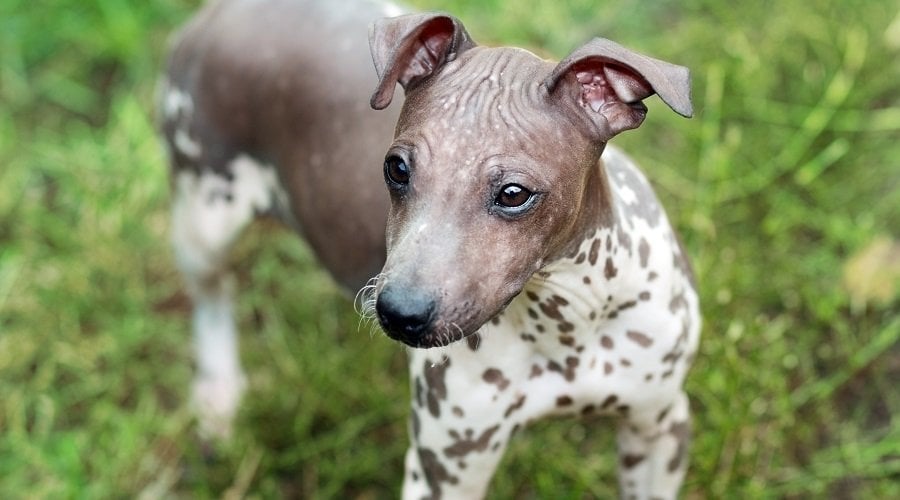
There are two varieties of this pup, one hairless and one haired, but even the haired version sheds very little. The American Hairless originated as a natural offshoot of the Rat Terrier. In Louisiana in 1972, a hairless pup was born in a normally-haired Rat Terrier litter. More hairless puppies were born in subsequent litters, and their owners line-bred them to produce consistently hairless offspring per litter. Because there’s no hair to shed, these dogs won’t trigger most allergy sufferers, but they must be indoor-only dogs because they’ve lost that layer of protection.
Unlike other hairless breeds, the hairless trait in AHTs is recessive, meaning two hairless parents will always produce hairless offspring, while coated parents might produce hairless offspring within a litter. If a coated AHT is bred to a hairless AHT, the chances of having hairless pups depend on whether both coated parents carry the recessive trait. AHT pups are born with light vestigial fur – almost like the hair on a human newborn. This fur falls out when they are several weeks old.
Xoloitzcuintli
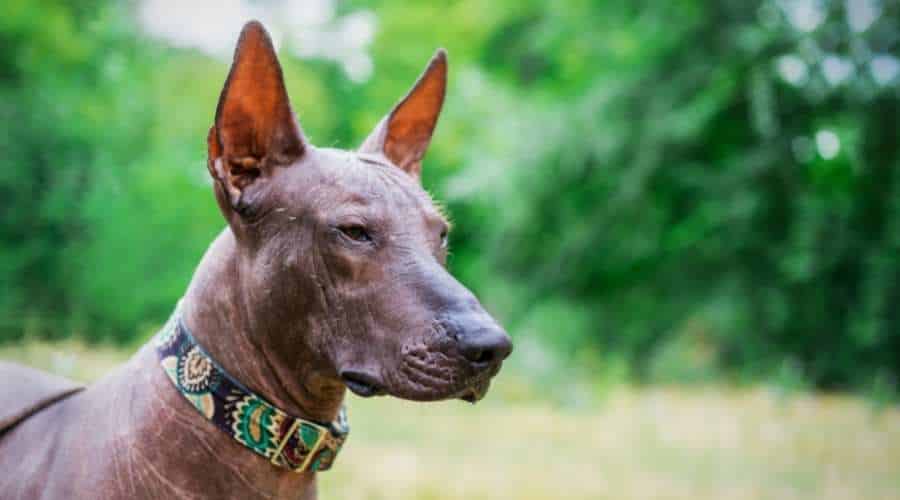
The Xoloitzcuintli also has three sizes, toy, miniature, and standard. The “Xolo”, the national dog of Mexico, was once known as the Mexican Hairless. Archeological evidence suggests ancient peoples believed them to guard not only against mortal intruders but evil spirits. Archeologists have found specimens interred with their owners to guide their souls to the underworld. Ancient people also consumed the dogs ceremonially.
The hairless variety has tough, smooth skin. The only place his skin may show wrinkles is his expressive face. He may have coarse, short hair on the top of his head, feet, and tail end. The coated variety has a short, flat coat. Xolos’ coats run dark, ranging from black through slate gray or red through bronze. If you have a Xolo, you’ll have to keep him out of the sun or use sunscreen on his skin so he doesn’t burn. He may have skin acne as a youngster.
Peruvian Inca Orchid

Like the Xolo, the Peruvian Inca Orchid (PIO) comes in three sizes and two coat types – one with hair and one without. The congenital alopecia that renders the PIO, the Xolo, and the Chinese Crested hairless is a dominant gene. In other words, as long as one parent has the trait, the litter will potentially contain hairless pups. All of the breeds with the alopecia gene may have faulty dentition, and this includes the PIO.
The hairless variety must be indoor dogs and need sunscreen if they’re outside for a prolonged period. Although not suited to live outdoors, they are considered primitive dogs, and their temperaments vary. They may be as relaxed as a more typical sighthound, but they could retain more feral characteristics. Households will very young children or small pets may wish to opt for a more predictable breed.
Chinese Crested

Another dog with two varieties, the Chinese Crested, almost certainly did not originate in China. Genetic evidence that the same mutation causes hairlessness in this breed as in the Xolo and the PIO suggests they share a common origin. Cresteds may be hairless (hair only on the head, feet, and tail) or powderpuff (covered with a double coat).
Hairless Cresteds have very little hair to shed, but their skin requires special care. Like people with sensitive skin, they often suffer from a wool allergy and sensitivities to fragrances and chemicals in products. When buying products for any hairless breed, check reviews and look for hypoallergenic products. Avoiding lanolin (oil from wool) and using a product with natural oils may help his skin stay smooth and irritation-free. Powderpuff Cresteds have long hair that doesn’t shed, but their coat requires daily de-matting.
Low-Shedding Breeds
Poodle

Poodles have hair instead of fur. Instead of shedding seasonally, their hair grows steadily. His hair requires daily brushing and combing, or he may develop mats near the skin. If this happens, you may need to have a professional groomer shave him so his hair can completely regrow.
Many people with dog allergies seek the Poodle specifically because they don’t shed like a regular dog. Although they are much better for allergy sufferers than a standard breed, they are not entirely hypoallergenic because no dog with hair can be. They still produce dander. If you are searching for a best friend and have severe allergies, consult with your doctor before bringing a pup into your home.
Bedlington Terrier

The Bedlington Terrier’s curly coat barely sheds but requires clipping every two months. You may learn to handle the necessary clippers and scissors to do this at home or take him to a professional. You’ll need to brush or comb him out once or twice weekly to keep him tangle-free.
Ironically, although Bedlington Terriers are less likely to trigger an allergy in their human companions, they often suffer from allergies. These allergies usually present as skin problems, and you’ll need to consult your vet about trying an elimination diet to rule out common food allergens as his trigger.
Lagotto Romagnolo

Originating in Italy, the Lagotto Romagnolo’s top and undercoat together repel water. His curly, semi-rough hair covers his body with ringlet curls. His coat resembles that of other dogs initially bred to retrieve waterfowl, but since the 1800s, he’s been used to detect truffles underground.
Because Lagottos don’t shed seasonally but may lose small tufts of hair occasionally, they need to be clipped to keep their curls no more than one and a half to two inches long. Some Lagotto coats mat more quickly than others, so he needs regular grooming and clipping to prevent his hair from becoming felted.
Havanese

The diminutive Havanese stands only eight and a half to eleven and a half inches tall and weighs a scant seven to thirteen pounds, but it looks like most of that is hair. Once they reach maturity at around age two and have their adult coat, their hair will be approximately six to ten inches long. Havanese have a double coat to protect them against temperature extremes. Both are soft and do not shed.
The Havanese coat requires daily care to keep his hair free of tangles. However, some people choose to clip their Havanese for convenience. If you keep his coat long, run a comb through it daily to remove mats and debris. Havanese bond strongly with their people and are sensitive to slight changes in mood or behavior, so the one-on-one attention he gets during your grooming sessions may be his favorite part of the day.
Bichon Frise

Happy-go-lucky and a friend to all, the Bichon Frise often tops lists of “hypoallergenic” dogs because their hair grows indefinitely and does not shed seasonally. Allergens exist in dead skin cells (dander), saliva, and urine, but most notably in their hair. Even though any dog with hair will lose some, the Bichon’s coat captures most of it.
The two coats together give him the look and texture of a powder puff. Although Bichons don’t shed like most dogs, they require daily brushing to remove hairs caught in their undercoat that can turn into mats if left too long. He’ll need his hair bathed and trimmed every four to six weeks. Just because a dog doesn’t shed much hair doesn’t mean his coat will be low maintenance.
Coton de Tulear

Coton de Tulears have double coats that don’t shed seasonally. Their outer coat captures loose hairs before they end up all over the house. While they’re easy to groom as pups before their double coats fully develop, their mature coats require specialized care. Establish weekly grooming routines when they are pups because once they have reached adulthood, you’ll need to commit considerable time to their cotton-like coat.
When you brush your Coton, gently detangle all the way to his skin using a pin brush or wide-toothed grooming comb. Excessive pulling may hurt his skin, so use a gentle, fragrance-free grooming spray daily to loosen his tangles as you brush and comb. Brushing out his mats daily helps avoid shaving him down to the skin, but many Coton owners opt for a puppy cut to ease maintenance.
Irish Water Spaniel

The Irish Water Spaniel’s dense, curly liver coat sheds little but requires a lot of care. If your Spaniel spends time in the field, you’ll first need to brush out any debris with a coarse brush. For the next step, comb through his hair to the skin with a wide-toothed comb. Go slowly, and if you encounter any mats, work them out with your fingers to continue combing them out.
You’ll probably want to keep your Irish Water Spaniel’s coat trimmed, so after he’s combed out and mat-free, brush against the grain of the hair with a slicker brush to remove all dead hair from his coat. Once his coat is fluffed, trim off any sunburned or frizzy ends to even up his coat with grooming scissors.
Kerry Blue Terrier

The curly blue coat of the Kerry Blue Terrier is as beautiful as it is low shedding. The cardinal rules of non-shedding coat care are don’t brush the hair dirty or dry and don’t wash the hair matted or tangled.
Depending on his outdoor exploits, you may be able to keep his coat tangle-free with a once or twice-a-week light brushing. Brush and comb his coat with a mist of water or grooming spray as needed, and plan for his deep grooming and bath about every six to eight weeks. After his bath, trim his coat or take him to a professional groomer to have him tidied up.
Maltese
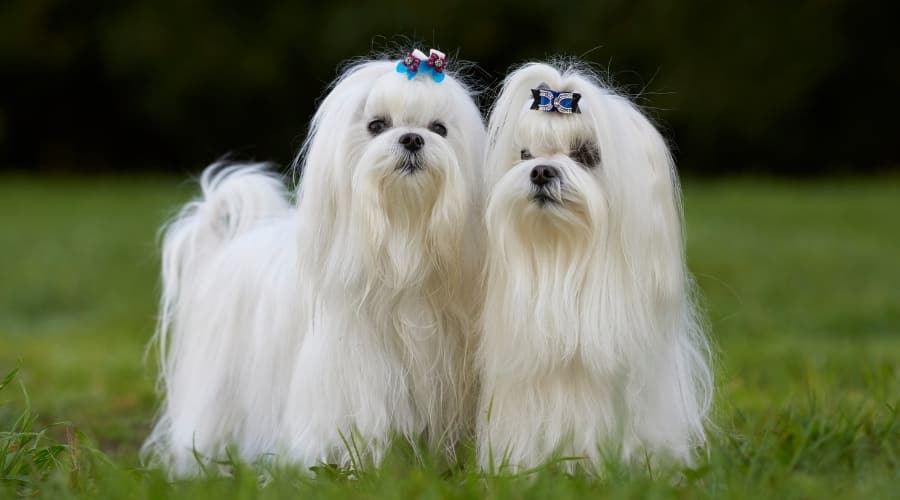
Maltese do shed, but their shedding is minimal. Some owners prefer keeping their Maltese in puppy cuts to make their long, silky coats easier to manage. Regardless of coat length, he needs to be de-matted using a wide-toothed comb to remain tangle-free. Puppy cuts may need to be combed twice a week, but if you choose to keep his coat long, you’ll need to comb him out every day.
Combing him out and then brushing him with a grooming spray will help remove loose hairs from his coat and limit hair breakage. He’ll need a bath once or twice a month to keep him clean and his coat flowing and healthy.
Spanish Water Dog

The Spanish Water Dog’s (SWD) unique coat is grooming-free but not free from maintenance. Never brush his coat, but keep it a uniform length. He doesn’t shed, and his coat continues to grow, so how long it gets is up to you. When his coat is too long, a professional groomer will clip him short, almost like shearing the wool off of a sheep.
The cords are what require maintenance. This breed’s coat cords differently than other corded breeds like the Komondor, and it’s best to learn how to manage it from someone with experience with the breed. Make sure his coat is clean when you eventually take him to the groomer to be clipped. Wash him like a sweater by squeezing the shampoo and conditioner through his cords and pat him dry or air dry.
Afghan Hound
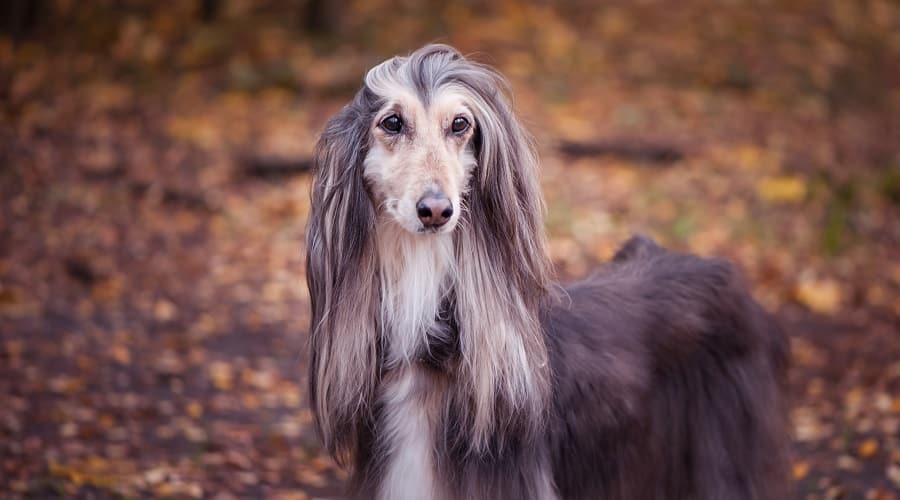
Afghan Hounds may not look like a minimally shedding breed at first glance simply from their size, around twenty-seven inches at the shoulder, and the length of their hair. Their long, silky coats protected them from the harsh environment in which the breed developed. When sighthounds from Northern Africa were brought to the much colder mountains of Afghanistan, hunters selected the dogs with the most protective coats and created the Afghan breed.
Afghan Hounds shed minimally, but their coat requires much attention to keep the hair from matting and breaking off. Some groomers recommend bathing and conditioning before a complete grooming session, but gently brushing his coat daily with a grooming spray will help avoid matting as much to keep his coat silky and flowing.
Schnauzer

Like many of these low-shedding dogs, Schnauzers come in three sizes, albeit on the larger end of the scale: Miniature, Standard, and Giant. The outercoat retains its waterproof nature and traps any shed hairs if stripped instead of clipped. If they are clipped, they pick up more dirt and debris and lose more shed hairs in the house.
Hand-stripping, your Schnauzer, maybe a job for a professional groomer, but if you want his coat to function optimally and naturally reduce the amount of hair he loses, it’s worth the effort. Not only does hand-stripping your Schnauzer’s coat limit shedding, but it stimulates new coat growth and preserves the richness of his coat color.
Soft Coated Wheaten Terrier

The Soft Coated Wheaten Terrier’s silky coat sheds minimally, but his coat requires work to keep it from matting. He requires daily brushing and de-matting, first with a pin brush and then with a medium and fine-toothed comb. The color of wheat with a luminous shine, his single wavy coat requires more maintenance than you’d think.
You’ll need the proper tools to care for his coat, so plan to buy a Greyhound comb, a pin brush, a slicker brush, and two sets of shears, one of which should be thinning shears that only cut part of the hair you trim. Brush him in small sections to get the larger mats and debris out of his coat, then go back with a comb and gently work through any remaining knots with your fingers, the comb, and a grooming spray if necessary.
Managing Shedding
Vacuuming
While vacuuming is nothing fun, it is one more tool in the arsenal against pet hair. If your air purifier eliminates the airborne particulates that trigger your allergies, a mechanical vacuum can take care of anything that lands on surfaces in your home or car. The best vacuum is lightweight, so you’ll use it frequently, and versatile enough to tackle multiple surfaces in your home and elsewhere.
While it is a traditional handheld stick vacuum, the Bissell Featherweight Cordless XRT also includes specialized pet tools. It converts to a handheld vacuum with a crevice tool and upholstery brush to get pet hair wherever it settles. This lightweight vacuum handles hard surfaces and area rugs but may not have the power for a home with wall-to-wall carpets. Carpet is a significant factor in how much hair and dander stay trapped in a room. You may consider the more powerful Bissell ICONPet Edge for fully carpeted homes.
Air Purification
You can minimize how much your pup sheds with good nutrition and frequent grooming, but you can’t stop him from shedding. Adding air purification to your home has benefits beyond tackling dog hair, but it’s one more way to reduce the amount of hair in your home and the allergens in the air. The most significant allergen dogs introduce is dander, the dead skin cells constantly sloughing and falling along with shed hairs.
Dog dander is roughly 2.5 microns, although it may be larger. An air purifier that effectively eliminates airborne particulates smaller than this can significantly reduce the amount of pet dander available to trigger allergic symptoms. The Filtrete Air Purifier FAP-C03BA-G2 claims to capture 99.97% of airborne particles (as small as 0.3 microns), including dust, lint, dust mite debris, mold spores, pollen, pet dander, smoke, smog, bacteria, viruses, exhaust particles, and ultrafine particles.
Final Thoughts
As much as we love our dogs, we don’t always love what they leave behind on the sofa. If you want canine companionship, but due to allergies or other needs, you can’t be around a lot of pet hair or dander, you may have options. Consider a hairless breed, or aim towards a coated breed that sheds very little.
Don’t forget that low shedding doesn’t mean low maintenance. If you choose a hairless breed, you’ll need to be careful to protect his skin from the sun and the elements. He’ll need a jacket for cold weather, and his skin will be prone to more irritation because he lacks the protective layer of fur. A low-shedding breed with hair that grows perpetually requires frequent and often labor-intensive or expensive grooming. If you’re willing to put in the time and energy, you’ll find the best friend of your dreams.
